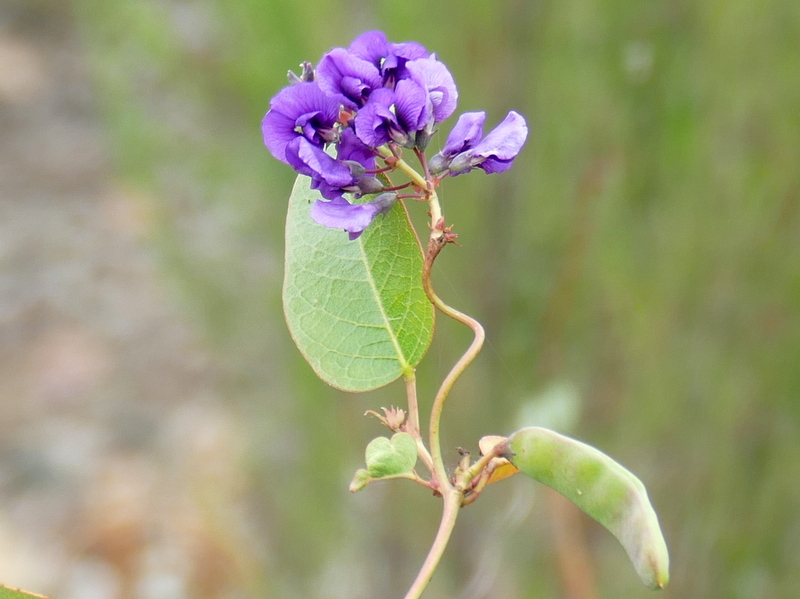
Hardenbergia flowers glowing on a dull spring afternoon in Canberra. Photo: Ian Fraser.
The contribution of broken hearts to the advancement of Australian botany has, I think, been underestimated.
What is more obvious is that very few plants bear women’s names; this is a story that combines the threads, though not perhaps as you might suppose.
Carl Alexander Anselm, the Baron von Huegel, was born in Bavaria, the son of a diplomat with the imposing title of Concommissarius of the Reichstag, who nonetheless had to flee with his family to Austria at the turn of the 19th century when young Carl was only five.
Carl later fought in the Austrian cavalry against Napoleon, returning to civilian life and his passion for natural history in 1824, where he had two great loves. One was his magnificent Vienna garden which featured many of the then fashionable plants of New Holland; the other was his fiancée Melanie.
This comfortable and rewarding life was turned violently upside down when Melanie, under great pressure from Carl’s patron, the formidable and ruthless Chancellor Prince Metternich, was forced to break off her engagement to Carl in favour of the prince.
Carl couldn’t bear to stay in the same city, and in his words became ‘a man who sought healing and oblivion in every land on earth’. It was another 20 years before he himself married.
Meanwhile he travelled, collecting plants and sending a flood of them back to Europe, for five years in Asia and, in 1834, Australia. I would recommend his diaries of this time here, translated by Dymphna Clarke as New Holland Journal.
Later in his stay he was highly critical of what he saw as the crudity and crass commercialism of Australian society. He was also dismayed by the brutal convict system and the treatment of Indigenous people. Later still in his life he relented and wrote with nostalgia of his time here.

The typical pea flowers of Hardenbergia on the twining stem. Photo: Ian Fraser.
Finally back home a hero, having sent 32,000 natural history specimens ahead of him, he became a diplomat and was recognised by international scientific organisations.
Before his return to Europe though, many of his specimens were received and preserved by his sister, Franziska von Hardenberg. She had married into one of Germany’s leading families, so presumably had the time and resources to devote to caring for his collections.
Among the specimens was a beautiful and profuse sprawling pea shrub with rich purple flowers, on which was bestowed Franziska’s married name – Hardenbergia, one of the very few genus names honouring a woman.
In south-eastern Australia, Hardenbergia violacea, known as Happy Wanderer or False Sarsparilla, is very familiar to us, scrambling across the ground and through other foliage in both gardens and the bush.
It often adorns roadsides and can also colonise bare ground, even in quarries, due to the wonderful pea trick of harnessing bacterial colonies in its roots to fix atmospheric nitrogen in a special partnership.
These bacteria do what no plant can do alone, that is, take nitrogen directly from the air and convert it to plant-friendly ammonium salts for use in essential chemical processes, so that peas don’t need to compete with other plants for these scarce salts in the soil.
Remarkably, the root recognises the chemical profile of the bacteria in the soil and lowers its defences to invite them in.

Hardenbergia sprawling to cover bare ground on Black Mountain. Photo: Ian Fraser.
First Australian people boiled the leaves to make a sweet infusion. Unsurprisingly, as so often happened, European settlers learnt from their predecessors and adopted this practice to obtain a tea substitute, hence the False Sarsparilla name.
I’d like to imagine Carl and Franziska, brother and sister, in later years sitting down to chat over a nice pot of Hardenbergia tea, but – nah, probably not.
Their plant however delights us every year in spring, though probably more in a park or garden than in a teapot.
Ian Fraser is a naturalist, conservationist and author. He has written on all aspects of natural history, advised the ACT Government on biodiversity and published multiple guides to the region’s flora and fauna.
Original Article published by Ian Fraser on Riotact.








